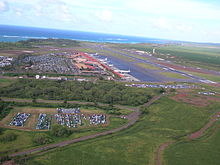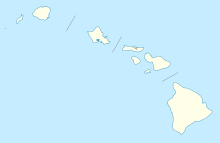- Kahului Airport
-
Kahului Airport 
Aerial view of the airport IATA: OGG – ICAO: PHOG – FAA LID: OGG Location of the Kahului Airport Summary Airport type Public Operator Hawaii Department of Transportation Serves Kahului, Hawaii Hub for Pacific Wings Elevation AMSL 54 ft / 16 m Coordinates 20°53′55″N 156°25′50″W / 20.89861°N 156.43056°WCoordinates: 20°53′55″N 156°25′50″W / 20.89861°N 156.43056°W Website Runways Direction Length Surface ft m 2/20 6,995 2,132 Asphalt 5/23 4,990 1,521 Asphalt Helipads Number Length Surface ft m H1 125 38 Asphalt Statistics (2009, 2010) Aircraft operations (2009) 247,337 Based aircraft (2009) 56 Passengers (2010) 5,346,694 Source: Federal Aviation Administration[1] Kahului Airport (IATA: OGG, ICAO: PHOG, FAA LID: OGG) is a regional airport in the state of Hawai'i, located east of the Kahului CDP in Maui County on the island of Maui near Haleakala.[2] Most flights into OGG originate from Honolulu International Airport; the Honolulu–Kahului corridor is one of the busiest air routes in the US, ranking 13th in 2004 with 1,632,000 passengers.[3] (If "route" refers to a single pair of airports, HNL-OGG has been at or near the top of the US list for decades.[citation needed])
The airport code pays homage to aviation pioneer Bertram J. Hogg who worked for what is now Hawaiian Airlines flying aircraft ranging from 8-passenger Sikorsky S-38 amphibians to Douglas DC-3s and DC-9s into the late 1960s.[4]
Contents
Authority
Kahului Airport is part of a centralized state structure governing all of the airports and seaports of Hawai'i. The official authority of Kahului Airport is the Governor of Hawai'i. The Governor appoints the Director of the Hawai'i State Department of Transportation, who has jurisdiction over the Hawai'i Airports Administrator.
The Hawai'i Airports Administrator oversees six governing bodies: Airports Operations Office, Airports Planning Office, Engineering Branch, Information Technology Office, Staff Services Office, Visitor Information Program Office. Collectively, the six bodies have authority over the four airport districts in Hawai'i: Hawai'i District, Kaua'i District, Mau'i District and the principal O'ahu District. Kahului Airport is a subordinate of Mau'i District officials.
Facilities and aircraft
The Kahului Airport terminal building has ticketing, USDA agricultural inspection, and baggage claim areas on the ground level.
18 jetways are available for enplaning or deplaning passengers (there are six gate hold areas designated A-F with 3 jetways each). Gates with odd numbers have jetway systems, while gates with even numbers are designated as emergency exits and have stairs that leads to the tarmac below.
Most of the gates were spaced to handle narrow-body aircraft like the Boeing 717 and Boeing 737 used on inter-island flights. In 1982-83 Kahului started getting nonstop flights from the mainland United States; these now use wide-body aircraft like the Boeing 767 and Boeing 777, along with the Boeing 737-700, Boeing 737-800 and Boeing 757. The smaller aircraft used on inter-island flights fit at all gates, while the larger overseas airliners cannot.
The airport is going through several phases of expansion authorized by the Hawai'i State Legislature. A long term goal has been set to prepare Kahului Airport for eventual elevation to permanent international airport status with regular service routes from Canada and Japan.[citation needed]Current flights from Canada use United States border preclearance facilities in Vancouver, Calgary or Edmonton.
Kahului Airport covers 1,391 acres (563 ha) at an elevation of 54 feet (16 m) above mean sea level. It has two asphalt runways: 2/20 is 6,995 × 150 feet (2,132 × 46 m) and 5/23 is 4,990 × 150 feet (1,521 × 46 m). It also has an asphalt helipad designated H1 measuring 125 × 125 feet (38 × 38 m).[1] Most commercial flights use runway 2.
For the 12-month period ending March 31, 2009, the airport had 247,337 aircraft operations, an average of 677 per day: 54% air taxi, 34% scheduled commercial, 11% general aviation and 3% military. At that time there were 56 aircraft based at this airport: 29% single-engine, 23% multi-engine, 45% helicopter and 4% ultralight.[1]
Airlines and destinations
Airlines Destinations Air Canada Vancouver
Seasonal: CalgaryAlaska Airlines Oakland, Portland (OR), Sacramento, San Diego, San Jose (CA), Seattle/Tacoma
Seasonal: AnchorageAmerican Airlines Dallas/Fort Worth, Los Angeles Continental Airlines Seasonal: Orange County [ends January 2][5] Delta Air Lines Los Angeles go! Mokulele operated by Mesa Airlines Honolulu Hawaiian Airlines Hilo, Honolulu, Kona, Las Vegas, Lihue, Oakland [begins January 11, 2012],[6] Portland (OR) [ends January 9, 2012], San Jose (CA) [begins January 10, 2012][7], Seattle/Tacoma Island Air Honolulu, Kona, Lihue, Molokaʻi Mokulele Airlines Kona, Molokaʻi Pacific Wings Hana, Kamuela/Waimea, Kona, Molokaʻi United Airlines Denver, Los Angeles, San Francisco
Seasonal: Chicago-O'HareUS Airways Phoenix WestJet Vancouver
Seasonal: Calgary, EdmontonTop destinations
Busiest Domestic Routes from OGG (June 2010 – May 2011)[8] Rank City Passengers Carriers 1  Honolulu, HI
Honolulu, HI987,000 go! Mokulele, Hawaiian, Island 2  Los Angeles, CA
Los Angeles, CA427,000 American, Delta, United 3  Seattle, WA
Seattle, WA183,000 Alaska, Hawaiian 4  San Francisco, CA
San Francisco, CA181,000 United 5  Portland, OR
Portland, OR131,000 Alaska, Hawaiian 6  Kona, HI
Kona, HI100,000 Hawaiian, Island, Mokulele, United 7  Phoenix, AZ
Phoenix, AZ91,000 US Airways 8  Dallas/Fort Worth, TX
Dallas/Fort Worth, TX75,000 American 9  Oakland, CA
Oakland, CA55,000 Alaska, Hawaiian 10  Sacramento, CA
Sacramento, CA49,000 Alaska Disasters
Aloha Airlines Flight 243
On April 28, 1988, Aloha Airlines flight 243, a Boeing 737-200 interisland flight from Hilo Airport to Honolulu International Airport carrying 89 passengers and 6 crew members experienced rapid decompression when an 18 foot section of the fuselage roof and sides were torn from the aircraft. One flight attendant was sucked out of the aircraft and died. Several passengers sustained life-threatening injuries including instances of massive head wounds. The aircraft declared an emergency and landed at Kahului Airport. Noise created by the rush of air rendered vocal communication useless, and the pilots had to use hand signals during landing.
Investigations of the disaster, headquartered at Honolulu International Airport, concluded that the accident was caused by metal fatigue. The disaster caused almost all major United States air carriers to retire their oldest aircraft models.[citation needed]
Aloha Island Air Flight 1712
On October 28, 1989, Aloha Island Air flight 1712, a de Havilland Canada DHC-6 Twin Otter aircraft, collided with mountainous terrain near Halawa Valley, Molokai, while en route on a scheduled passenger flight from Kahului Airport to Molokai Airport in Hoolehua.
The NTSB determined the cause of the accident was the airplane's controlled flight into terrain as a result of the decision of the captain to continue the flight under visual flight rules at night into instrument meteorological conditions, which obscured rising mountainous terrain.[9]
All 20 aboard the aircraft died. Thirteen of the victims were from Molokai, including eight members of the Molokai High School boys and girls volleyball teams and two faculty members. The girls team had just qualified on Maui for the state tournament.[10]
Hawaii Air Ambulance
On March 8, 2006, a Hawaii Air Ambulance Cessna 414 was making an approach to Runway 5 when it crashed into a BMW dealership just a mile outside of the airport. A pilot and two nurses were killed in the accident.[11]
Expansion
As a result of the passage of several Hawai'i State Legislature bills in 1998 and 2001, Kahului is planned to undergo expansion for new, larger facilities, lengthening of runways, increasing of fuel storage capacities, and construction of new access roads. A controversial project, it has met strong opposition from local residents who do not agree with prospects of elevating Kahului Airport to a permanent international airport. Project opponents cite concerns about increased introduction of invasive species and other issues, as evidenced by the common Maui bumper sticker "Big city airport, big city problems."
In early 2005, Governor Linda Lingle released $365 million for construction of an extended ticketing lobby, new baggage claim carousels, a new Alien Species building, a new cargo building, construction of a new apron, construction of an additional 10 jetways to replace the current jetways, and a new six-lane airport access road that would run from the airport, intersecting Haleakala Highway and Hana Highway, and run parallel to Dairy Road where it would merge with a new grade-separated interchange between Puunene Avenue (highway 350), Dairy Road, and Kuihelani Highway (highway 380).
References
- ^ a b c FAA Airport Master Record for OGG (Form 5010 PDF). Federal Aviation Administration. Effective 29 July 2010.
- ^ "Kahului CDP, Hawaii." U.S. Census Bureau. Retrieved on May 21, 2009.
- ^ "Busiest Airline Routes in the United States – Table – MSN Encarta". Archived from the original on October 31, 2009. http://www.webcitation.org/5kwsAzbbt.
- ^ English, Dave (December 1994). "Airport ABCs: An Explanation of Airport Identifier Codes". Air Line Pilot (Air Line Pilots Association, International). http://www.skygod.com/asstd/abc.html. Retrieved September 12, 2011.
- ^ http://www.ocregister.com/travel/maui-327355-continental-flights.html
- ^ "Hawaiian Airlines adding Maui-to-Oakland route". Pacific Business News (Honolulu). September 1, 2011. http://www.bizjournals.com/pacific/news/2011/09/01/hawaiian-airlines-adding.html. Retrieved September 1, 2011.
- ^ "Hawaiian Launching San José – Maui Service in January". Hawaiian Airlines (Honolulu). September 6, 2011. http://investor.hawaiianairlines.com/phoenix.zhtml?c=82818&p=irol-newsArticle&ID=1604001&highlight=. Retrieved September 6, 2011.
- ^ http://www.transtats.bts.gov/airports.asp?pn=1&Airport=OGG&Airport_Name=Kahului,%20HI:%20Kahului%20Airport&carrier=FACTS
- ^ http://www.airdisaster.com/reports/ntsb/AAR90-05.pdf
- ^ Honolulu Star-Bulletin Local News
- ^ "Three killed in air ambulance crash on Maui". The Honolulu Advertiser. March 8, 2006. http://the.honoluluadvertiser.com/article/2006/Mar/08/br/br06p.html. Retrieved March 9, 2006.
External links
- Hawaii DOT page for Kahului Airport
- Kahului Airport (information)
- FAA Airport Diagram (PDF), effective 20 October 2011
- FAA Terminal Procedures for OGG, effective 20 October 2011
- Resources for this airport:
- AirNav airport information for PHOG
- ASN accident history for OGG
- FlightAware airport information and live flight tracker for PHOG
- NOAA/NWS latest weather observations for PHOG
- SkyVector aeronautical chart for OGG
Airports in Hawaii Hawaii Island Oahu Kauai Maui Smaller islands Military Categories:- Airports in Hawaii
- Buildings and structures in Maui County, Hawaii
- Transportation in Maui County, Hawaii
Wikimedia Foundation. 2010.

